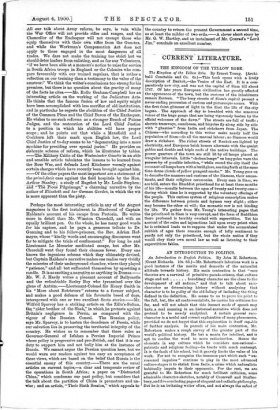C GRRENT LITERAT LIRE.
THE KINGDOM OF THE YELLOW ROBE.
The Kingdom of the Yellow Robe. By Ernest Young. (Archi- bald Constable and Co. Cs.)—This book opens with a lively description of Bankok,—the Venice of the East. It is a com- paratively new city, and was not the capital of Siam till about 1;67. Of late years European civilisation has greatly affected the appearance of the town, but the customs of the inhabitants remain Eastern. "The busy streets of Siam's capital present a never-ending procession of curious and picturesque scenes. With -the first faint glimmer of light in the East the life of the city begins. The approach of- day is heralded with the sonorous voices of the huge gongs that are being vigorously beaten by the official welcomer of the dawn." The streets are full of traffic ; electric tramways, omnibuses, and bicycles fly along side by aide with " gharries" from India and rickshaws from Japan. The Chinese—who according to this writer make nearly half the population of Siam—do all the manual labour; no Siamese would draw a rickshaw. The richer streets of Bankok are lighted by electricity, and European brick houses alternate with the quaint gables and double and triple roofs of the native buildings. The poorer quarters of the town are still lit by oil lamps placed at irregular intervals. Little "cholera lamps" on long poles warn the passers-by of possible infection, "while round the city itself the cocoanut-oil lamps barn with a lurid glare, sendingforth at the same time dense clouds of yellow pungent smoke." Mr. Young goes on to describe the manners and customs of the Siamese, their amuse- -Aleuts, and their religious ceremonies. Every man in Siam, we are told, enters the Bhuddist priesthood for at least three months of his life—usually between the ages of twenty and twenty-one— during which time he is supported by the voluntary offerings of the people. This curious system of religious conscription makes the difference between priests and laymen very slight ; either may become the other at will; the monastic vow is not binding for life. We gather from Mr. Young's interesting pages that the priesthood in Siam is very corrupt, and the form of Buddhism there professed is terribly overlaid with superstition. Yet his ace:dui:it of the rules and injunctions laid upon every priest when he is ordained leads us to suppose that under the accumulated rubbish of ages there remains enough of lofty sentiment to purify not only the priesthood, but the whole nation if they would obey their own moral law as well as listening to their superstitious fables.


































 Previous page
Previous page